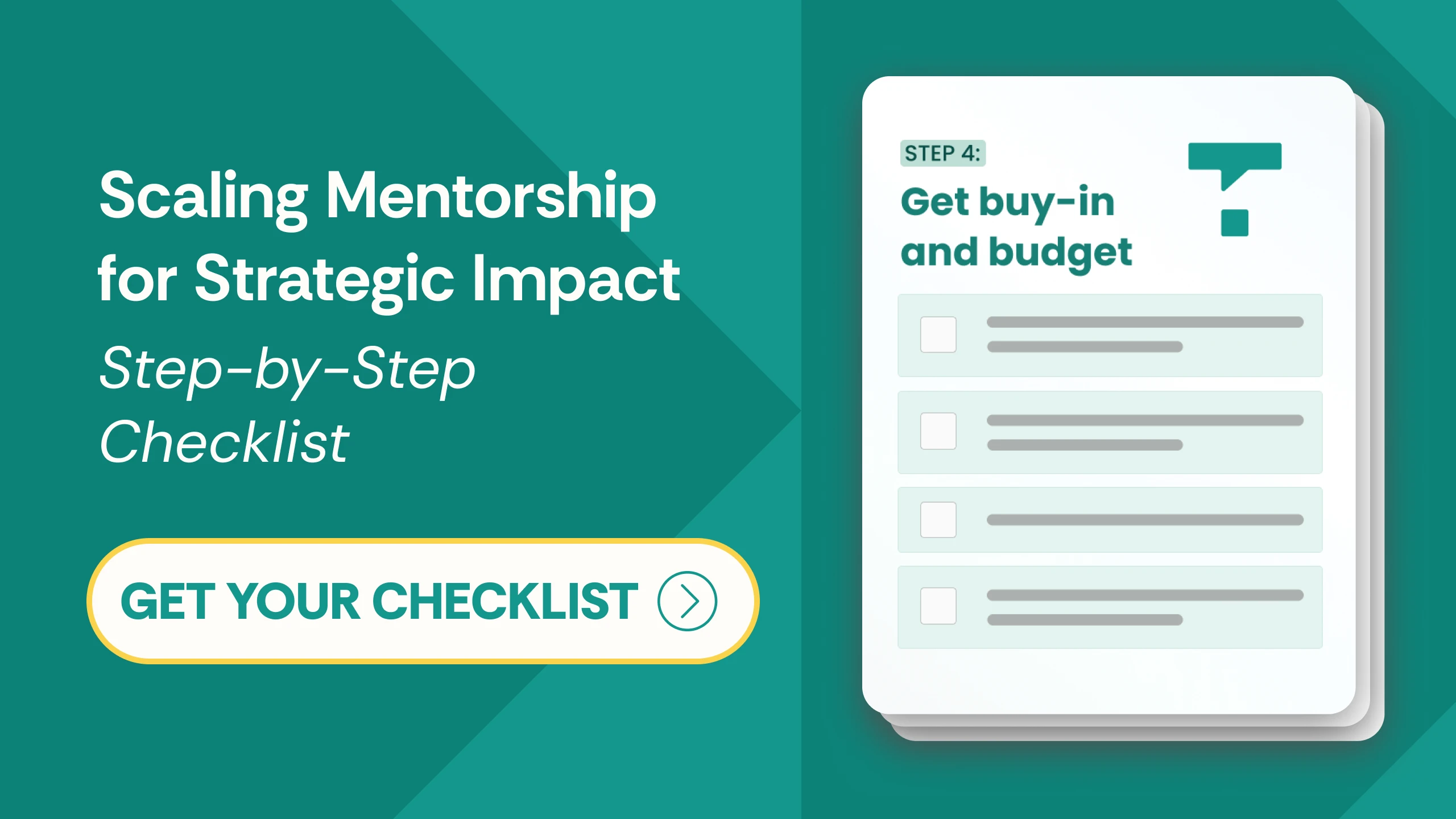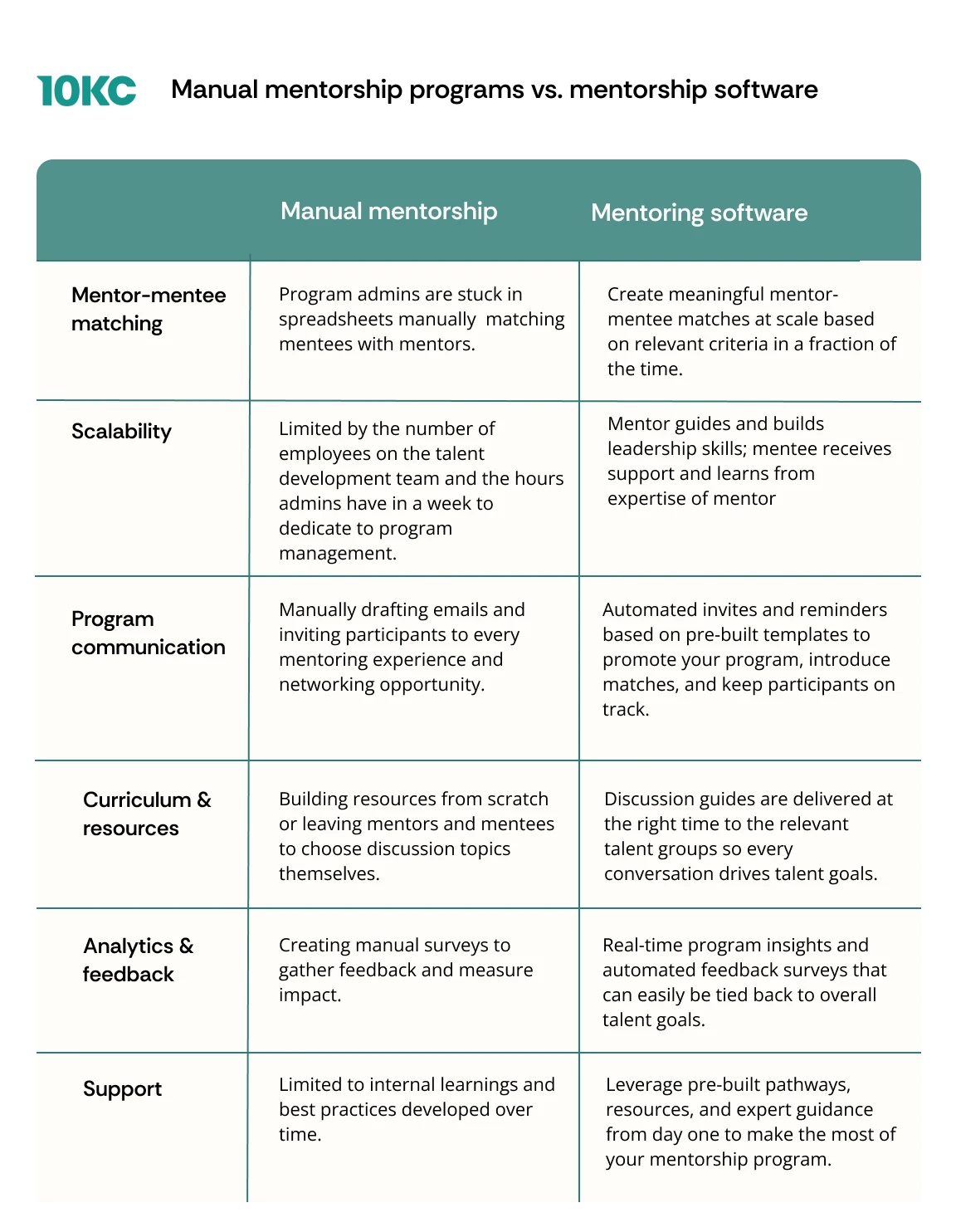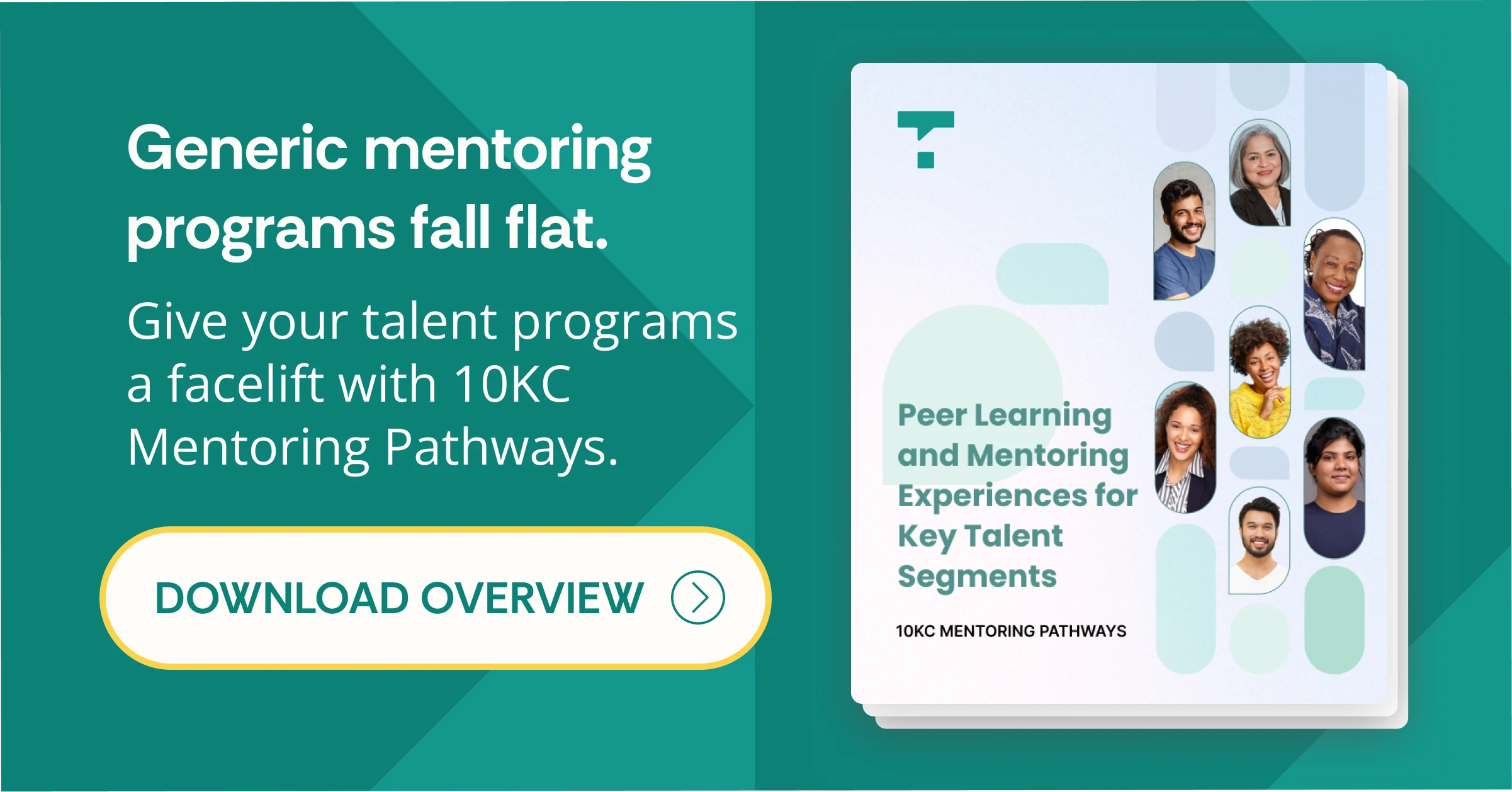Most organizations understand that mentorship matters. It’s a widely supported idea, and your company leaders likely agree that learning from others is one of the most powerful ways to grow.
Even so, mentoring often gets treated like a side-of-desk initiative. It's underfunded, informally run, and frustratingly hard to measure.
That has to change.
Mentorship is a strategic enabler of the talent outcomes your business needs to thrive, impacting:
- Engagement
- Retention
- Internal Mobility
- Development
And without the right infrastructure in place, your ability to scale impact—or prove it—will always fall short. Here’s why investing in mentorship software is no longer optional for your talent strategy.
Stakeholders want mentorship ROI, not just good intentions
Getting stakeholder buy-in for mentorship programs can be an uphill battle. Not because leaders don’t believe in the concept—but more likely because they can’t see the results. In today’s economic climate, every initiative is scrutinized for value. That means HR and talent teams must show measurable alignment between mentorship and strategic outcomes.
The good news? The ROI is real when mentorship is done right. Organizations that invest in structured, tech-enabled mentorship programs see measurable gains across key talent KPIs:
- Employee retention: Turnover is costly. It disrupts teams, slows down productivity, and drives up hiring expenses. Structured mentorship helps employees feel invested in, valued, and supported—boosting loyalty and reducing churn. For instance, 10KC mentorship software has seen that employee participants in our mentorship programs are 30% less likely to leave their organization.
- Employee engagement: Mentorship builds connection, and connection drives engagement. When employees feel seen, supported, and part of something bigger, they’re more likely to thrive. Studies show that 91% of employees with mentors say they’re satisfied in their roles. With 10KC mentorship software, 88% of employee participants feel more connected to their colleagues after participating in mentorship. This sense of purpose and belonging is a critical driver of effort, loyalty, and advocacy.
- Employee development: Mentorship connects formal learning with practical experience, offering personalized guidance that accelerates growth. No wonder 75% of executives credit mentorship as a key driver of their career success. And 90% of 10KC employee participants report learning new skills that directly support their career goals.
- Internal mobility: Mentorship helps employees gain the knowledge, confidence, and exposure they need to take the next step within your organization. In fact, participants in programs through 10KC mentorship software are 60% more likely to make internal moves, helping companies reduce external hiring costs and fill roles faster with trusted, homegrown talent.
- DEI impact: Mentorship is a proven way to close opportunity gaps and elevate underrepresented talent. With structure, visibility, and access to influential networks, diverse employees can thrive and rise. Studies show that mentoring can increase the representation of equity-seeking groups in management by up to 24%. It’s one of the most effective levers HR teams can pull to drive meaningful DEI progress.
📌 READ MORE: 20 Proven Benefits of Mentoring for Employees, HR Objectives, and Your Business
“You've got to understand the different groups and what will be valuable for them. Looking at the data that you have, talking to people, getting a pulse check on what their priorities might be, talking to the employees themselves, talking to leaders in those areas, talking to HR business partners. I can't stress enough how much value you get from deeply understanding the people you're trying to serve.” - Christine Silva, Talent Advisor, former leader at RBC, Catalyst, Shopify
Why managing mentorship manually won’t get you there
Business truth: unstructured mentoring = inconsistent impact and invisible ROI.
Unstructured mentorship programs (or any business initiatives, really!) rarely deliver the clarity or consistency needed to build lasting support. And when participation lags or outcomes are fuzzy, momentum fizzles fast.
Even when HR and talent teams know mentorship is critical, too many are still managing programs manually with spreadsheets, email chains, and ad hoc check-ins. The result?
Mentorship programs that are:
- Unscalable: Heavy admin burden limits reach and growth
- Unmeasurable: No visibility into what’s working or what’s not
- Unreliable: Outcomes hinge on individual effort, not a repeatable system

📣 Mentorship software isn’t just a logistical tool for running programs. It’s a strategic investment in your people, your culture, and your bottom line.
With the right platform in place, mentorship becomes measurable, repeatable, and scalable—delivering the outcomes your stakeholders expect, and the data to prove it.If mentorship is critical to your talent strategy, it deserves purpose-built infrastructure that can support it at scale.
“Social learning is often done manually, which limits how many people you can reach. [...] When you're thinking about innovation and where to point it—where you're looking to do it more deliberately and at scale—don’t let the manual work constrain the impact you can have. As you start to think about how technology can help you, start from business priorities. What is it that leaders are talking about? Could be your HR leaders, could be your business leaders. Have there been wide scale ambitions declared for the next few years? Take a look at them, whatever they are. Are they about revenue, are they about technology, and what conversations and connections could help enable those?” - Christine Silva, Talent Advisor, former leader at RBC, Catalyst, Shopify
Manual mentorship programs vs. mentorship software
Even the best mentorship programs can fall short if they’re stuck in spreadsheets and email chains. Manual approaches are time-consuming, hard to scale, and nearly impossible to measure, leaving HR teams without the tools to prove impact. Here’s how mentorship software changes the game:
Mentor-mentee matching
Manual mentorship: Program admins are stuck in spreadsheets manually matching mentees with mentors.
Mentoring software: Create meaningful mentor-mentee matches at scale based on relevant criteria in a fraction of the time.
Scalability
Manual mentorship: Limited by the number of employees on the talent development team and the hours admins have in a week to dedicate to program management.
Mentoring software: Mentor guides and builds leadership skills; mentee receives support and learns from expertise of mentor
Program communication
Manual mentorship: Manually drafting emails and inviting participants to every mentoring experience and networking opportunity.
Mentoring software: Automated invites and reminders based on pre-built templates to promote your program, introduce matches, and keep participants on track.
Curriculum & resources
Manual mentorship: Building resources from scratch or leaving mentors and mentees to choose discussion topics themselves.
Mentoring software: Discussion guides are delivered at the right time to the relevant talent groups so every conversation drives talent goals.
Analytics & feedback
Manual mentorship: Creating manual surveys to gather feedback and measure impact.
Mentoring software: Real-time program insights and automated feedback surveys that can easily be tied back to overall talent goals.
Support
Manual mentorship: Limited to internal learnings and best practices developed over time.
Mentoring software: Leverage pre-built pathways, resources, and expert guidance from day one to make the most of your mentorship program.

8 ways mentorship software enables results-driven, scalable talent strategy
The right platform doesn’t just manage your mentorship program—it powers your people strategy. Here’s what best-in-class mentorship software (like 10KC) unlocks:
1. Mentorship program centralization
Unify mentoring efforts across teams, locations, and employee levels, all within one platform. With central oversight, you can manage multiple program tracks while tailoring experiences by function, geography, or audience.
Why it matters: A centralized hub increases consistency, eliminates silos, reduces admin friction, and makes it easier to scale successful programs across the business.
2. Multiple social learning formats
Support diverse learning experiences by offering more than just traditional 1:1 junior to senior mentoring with flexible formats like peer mentoring, group sessions, networking, and more.
Why it matters: Multi-format programs ignite more collaborative knowledge-sharing, increase engagement, and create more inclusive experiences that meet employees where they are—whether they’re new grads or senior leaders.
3. Smart mentor-mentee matching
Use AI-powered matching algorithms and data inputs (goals, skills, interests, level, function) to create effective, values-aligned matches at scale.
Why it matters: Better matches drive stronger relationships, deeper trust, and higher impact. Mentees in strong matches are more likely to reach their individual goals, sustain long-term engagement, and drive you towards your organizational goals, too.
4. Resources that drive growth and conversation
Equip participants with curated discussion guides, learning prompts, and templates to support meaningful conversations and accelerate development.
Why it matters: Resources reduce friction, build confidence (especially for first-time mentors/mentees), and ensure mentoring time is purposeful and productive.
5. Structured programs tailored to different cohorts
Mentoring can’t be one-size-fits-all. High-impact programs recognize that different employee segments—from early-career talent to new managers to rising leaders—have distinct goals and development needs. That’s why the most effective organizations design structured programs tailored to each cohort.
With the right mentorship software, you can support multiple, personalized learning journeys in parallel—ensuring each participant gets relevant support at the right moment. (Think: curated, goal-aligned pathways like those built with 10KC Pathways.)
Why it matters: Structure brings clarity and consistency, so employees know what success looks like, and program leaders can track progress against strategic objectives. When pathways are aligned to the needs of defined cohorts, mentoring becomes more relevant, more engaging, and more likely to deliver measurable business outcomes.
6. Reporting and analytics
Track, analyze, and optimize every aspect of your mentoring programs. From participation metrics to HR business objectives, goal attainment, and sentiment data, mentorship software dashboards should deliver the insight stakeholders demand.
Why it matters: Data builds credibility, secures long-term investment, and helps you continuously improve the employee experience. You can finally prove ROI—not just assume it.
7. Integrations
Integrate with your existing HRIS, LMS, Slack, Teams, and other core platforms to bring mentorship into the flow of work.
Why it matters: Frictionless access boosts engagement, while centralized data ensures mentorship aligns with broader talent systems and workflows.
8. Automated communications
Automated communications eliminate the manual lift of running a mentorship program, freeing up program admins to focus on strategy instead of logistics. From pre-built email templates to smart segmentation and nudges, automation helps you:
- Promote your program efficiently with targeted invitations and engaging messages
- Segment audiences to ensure the right people are invited to the right opportunities
- Keep momentum high with timely reminders, check-ins, and scheduling prompts
- Embed mentorship into daily work through integrations with communication tools
Why it matters: Automation increases consistency, scales reach, and improves the participant experience, without requiring more hours from your team. It’s the key to running high-touch, high-impact programs without high overhead.
These capabilities aren’t just theoretical. They’re transforming how leading organizations approach talent development. From scaling mentorship across global teams to reducing attrition and accelerating internal mobility, forward-thinking companies are already seeing the impact of structured, software-powered mentorship in action.
📌 READ MORE: Choosing the Best Mentoring Software: A Buyer’s Guide
Real-life examples of companies upleveling with mentorship software
Horizon Media scaled mentorship enterprise-wide, transforming engagement and development
Horizon Media needed a scalable way to connect its hybrid workforce and deliver meaningful career development across geographies and roles. Manual efforts couldn’t support the scale, structure, or insight required to make mentorship stick.
That’s where 10KC mentorship software came in—providing smart matching, built-in structure, and real-time data to launch “THRIVE”, their company-wide mentoring initiative.
The result? Thousands of employees engaged and a 98% satisfaction rating from participants.
“Previously, we had separate mentorship program initiatives, but they weren't enterprise-wide, nor did they have a really strong capability for success measurement and performance tracking. We aligned that a more scaled mentorship and networking effort would help to support some of our broader culture and connectivity goals.” - Latraviette Smith-Wilson, Chief Marketing and Equity Officer, Horizon Media
📌 Read the full Horizon Media case study
Spring Health went from pilot to org-wide, cutting attrition in half
Spring Health identified a critical issue: attrition rates for Black and Hispanic or Latino employees were approximately three times higher than the company average. Recognizing the need for a more robust solution, Spring Health turned to 10KC.
Automated matching, structured curriculum, and real-time analytics enabled the expansion of their "Sprout with Spring" program from 42 participants to over 600 employees globally within six months. This strategic move led to a significant reduction in overall attrition, dropping from 32% to 15%, and fostered a stronger sense of belonging among employees.
“It became an argument that was self made. It's kind of a no brainer. We can decrease attrition, save money for the company, but then also really improve the overall employee experience.” - Michelle Rojas, Associate Director of Diversity, Equity, and Inclusion, Spring Health.
📌 Read the full Spring Health case study

Mentorship is a business strategy. Treat it like one with 10KC mentorship software.
The future of talent development isn’t built on gut feel or goodwill. It’s built on intentional infrastructure that scales what works.
With 10KC mentorship software, you can:
- Launch tailored, measurable mentorship programs across your organization
- Connect employees across functions, levels, and geographies
- Drive outcomes that matter: retention, engagement, internal mobility, development, and DEI impact
- Show your stakeholders the ROI of your talent investments
You’re already doing the work to grow your people. Now it’s time to amplify that effort—and prove its value—with mentorship and peer learning that’s built to amplify your talent strategy.









.png)